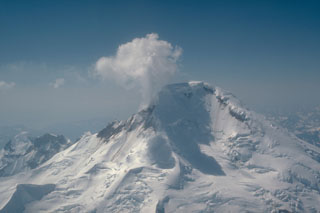Report on Iliamna (United States) — August 1996
Bulletin of the Global Volcanism Network, vol. 21, no. 8 (August 1996)
Managing Editor: Richard Wunderman.
Iliamna (United States) Seismicity rises; 40 metric tons/day of SO2
Please cite this report as:
Global Volcanism Program, 1996. Report on Iliamna (United States) (Wunderman, R., ed.). Bulletin of the Global Volcanism Network, 21:8. Smithsonian Institution. https://doi.org/10.5479/si.GVP.BGVN199608-313020
Iliamna
United States
60.032°N, 153.09°W; summit elev. 3053 m
All times are local (unless otherwise noted)
Seismicity began to increase on 1 August and persisted for the whole month. Several to 20 events of M 0.1-3.2 were recorded each day at depths from within the volcanic edifice to 9 km below sea level. All events seemed to be volcano-tectonic, and no long-period earthquakes or tremors that usually precede eruptions were observed. A similar but less intense cluster of earthquakes also occurred during mid-May of this year. AVO installed two additional seismic stations on the volcano in late August in order to increase the detection sensitivity and improve earthquake locations.
Two flights were conducted in late August to measure volcanic gas emissions. SO2 flux was at the background rate of ~40 t/d. CO2, often indicative of magmatic degassing, was also detected.
Geological Summary. Iliamna is a prominentglacier-covered stratovolcano in Lake Clark National Park on the western side of Cook Inlet, about 225 km SW of Anchorage. Its flat-topped summit is flanked on the south, along a 5-km-long ridge, by the prominent North and South Twin Peaks, satellitic lava dome complexes. The Johnson Glacier dome complex lies on the NE flank. Steep headwalls on the S and E flanks expose an inaccessible cross-section of the volcano. Major glaciers radiate from the summit, and valleys below the summit contain debris-avalanche and lahar deposits. Only a few major Holocene explosive eruptions have occurred from the deeply dissected volcano, which lacks a distinct crater. Most of the reports of historical eruptions may represent plumes from vigorous fumaroles E and SE of the summit, which are often mistaken for eruption columns (Miller et al., 1998). Eruptions producing pyroclastic flows have been dated at as recent as about 300 and 140 years ago, and elevated seismicity accompanying dike emplacement beneath the volcano was recorded in 1996.
Information Contacts: Alaska Volcano Observatory (AVO), a cooperative program of a) U.S. Geological Survey, 4200 University Drive, Anchorage, AK 99508-4667, USA (URL: http://www.avo.alaska.edu/), b) Geophysical Institute, University of Alaska, PO Box 757320, Fairbanks, AK 99775-7320, USA, and c) Alaska Division of Geological & Geophysical Surveys, 794 University Ave., Suite 200, Fairbanks, AK 99709, USA.

